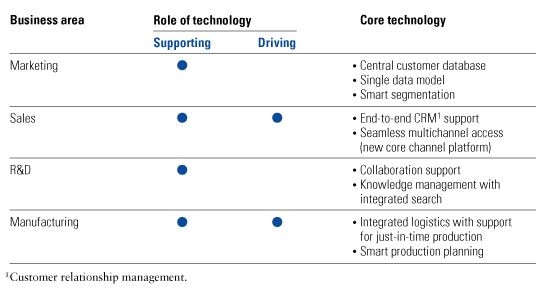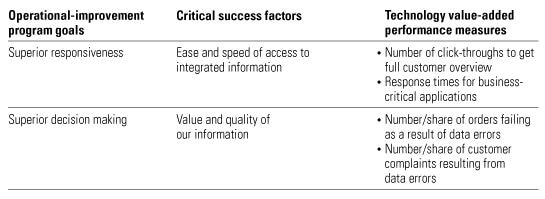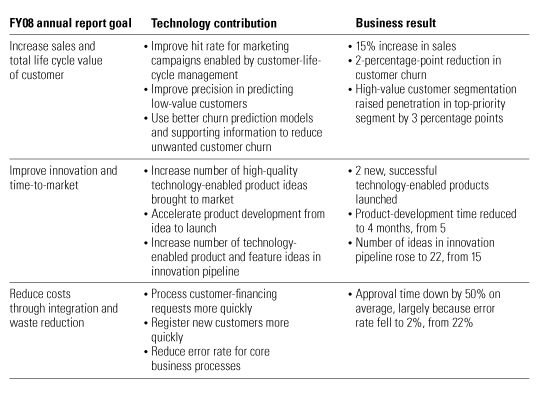To: The CEO
From: The CTO
Subject: Annual report for technology
At last week’s executive committee meeting, you made the point that our company’s business units and technology organization need to be much more in tune with each other. In this memo, I’d like to explain how we could take a joint step toward making that happen.
No one doubts that our company’s success depends on solid technology support. But everyone also believes that we can do a lot more to make technology serve the business units—for example, by deepening our insights into what customers need, integrating channels, speeding the delivery of services, and accelerating new-product development. We struggle to realize this potential.
The basic problem is a lack of shared understanding. Our business unit leaders have only a vague sense of the value the technology organization delivers: they just see bits and pieces and don’t seem to grasp the interdependencies. It’s understandable that they get upset when things go wrong, but it’s less understandable that they hesitate to invest time and energy to sponsor solutions. Our technology leaders, for their part, often fail to address issues in ways that businesspeople find meaningful and therefore lack credibility when they try to explain IT’s value to the business.
I’ve thought hard about how we could make more progress toward our goals. While I don’t claim to have the entire solution, I do have an idea that may bring us a big step closer. But in order for this solution to be successful, I will need your support and cosponsorship.
The idea is quite simple: you and I would jointly issue an annual report for technology—something analogous to the annual report for investors and the broader market. This document would not only provide a candid overview of our ability to extract business value from technology but also substantiate that analysis with hard metrics. We would share perspectives on the challenges of technology, convey our ideas about its role in our company, celebrate achievements, and articulate our plans and visions for the future.
To show that we are serious about bridging the gap between technology and the business units and to discourage people from seeing the report as an attempt by IT to plead its own case, it’s important that you and I issue the report jointly. Here’s how we could structure it.
CEO–CTO introduction
This opening section, framed as a letter-style executive summary, would introduce the idea behind the annual report for technology and the business rationale for issuing it: namely, to tell key stakeholders about technology’s performance over the past fiscal year, describe technology’s explicit contribution to meeting core business objectives, and explain the implicit value of the technology portfolio, along with our vision for the year ahead.
Supporting organizational agility
Technology underpins nearly every business process today, yet the connections aren’t always visible on the surface. This second section would provide stakeholders with a sort of anatomical chart of technology—a graphical representation illustrating where and how our company is using technology to support improvements and make us more agile.
Making connections visible

Aligning technology with business strategy
We know how easy it is for the interests of business and technology to diverge unless they are linked correctly, with effective metrics. In this third section, we would use numbers and stories to share our ideas about how technology creates value. The following examples might help put our performance-measurement program in context.
The operational-improvement program the board approved at the start of the fiscal year incorporated superior responsiveness and superior decision making into the core of the company’s strategic mission. To clarify technology’s role in supporting it, technology partnered with lean-team colleagues across the business units to identify critical success factors and suitable metrics.
Measuring IT’s support

The 2008 annual report set several goals for increasing sales, speeding up time-to-market, and reducing costs. The following chart illustrates technology’s role in supporting those business goals.
Linking IT to results

Such hard performance metrics are important, but you and I know that stories often put facts in context and can make a message more memorable. Therefore, we might consider including one or two sidebars about customers and employees. Here are two examples.
Sidebar 1The high-value customer John Doe of Premier Corporation is pleased that Bob Smith, his relationship manager at our company, no longer has to manage low-value clients and now devotes extra time to Premier and offers it many more innovative production ideas.
Sidebar 2Erica Sanchez, the controller in our industrial metals group, describes how our technology group integrated a suite of customer-financing applications to ease reporting, facilitate loan decisions, and reduce data entry risk.
Plans to use technology in new ways
This section, outlining the strategic reach of our technology program for the coming year, would focus on the two business principles you emphasized at our annual shareholder meeting: customer centricity and operational simplicity. To remain realistic and on track, we will ground our promises in a performance-measurement framework similar to the one described earlier. The intent, as always, is to establish the connection between our corporate vision and technology-enabled execution.
Technology capability statement
While our technology capabilities have come a long way, we know that we have only begun to develop the ability to support a streamlined, customer-centric company. This section would quantitatively discuss the improvements (or deterioration) in our enterprise technology capabilities over the past year, highlight technology’s progress in helping the company differentiate itself from competitors, and note where we need to improve. The featured initiatives could include our experimental customer cocreation center and our trial technology rotation program, in which technology specialists spend time in groups serving high-value market segments to speed up the development of new offerings.
Technology capability balance sheet
This section would offer a quantitative market valuation of our total technology portfolio, including tangible assets (such as hardware, data center facilities, and other physical properties), as well as key intangible assets (for instance, patents and signature R&D). The intent is to demonstrate not only the shareholder value embedded in our technology portfolio but also its return on investment and performance on other core financial metrics. In this way, the company can hold technology’s long-run performance to the same high standards the rest of our business is required to meet. Complementing the numbers, you and I will jointly provide an interpretation of them and share our perspective on how to raise the bar in the coming year. Examples and anecdotes will make the numbers come alive in the minds of the company’s executives.
The annual report for technology will help the executive team to see the big technology picture, improve communication and collaboration between the leaders of the business units and the technology organization, and allow the company to realize much greater value from technology. It will provide a new framework for more effective operations and, ultimately, better growth prospects.
I’m eager to start on the report. Let’s discuss the idea soon.
